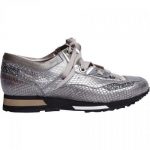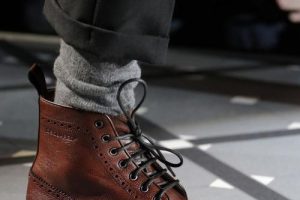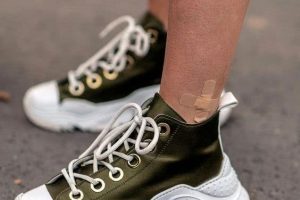Introduction
Shoes, far more than a practical necessity, have been essential elements of fashion and style for centuries. Among the many types of footwear available, men’s leather dress shoes stand out as timeless symbols of elegance, sophistication, and craftsmanship. This comprehensive article takes you on a journey through the fascinating realm of men’s leather dress shoes, exploring their history, the different styles, the art of wearing them, and the enduring appeal of these iconic pieces of men’s fashion.
A Glimpse into the History of Dress Shoes
Dress shoes have a history that spans centuries and reflects the evolution of fashion and craftsmanship. While today we primarily associate dress shoes with formal occasions, their origins were far more practical.
Early Days: Function Over Fashion
In the beginning, shoes were crafted primarily for protection. Ancient civilizations like the Egyptians, Greeks, and Romans made rudimentary leather footwear to shield their feet from harsh terrain and the elements. These early shoes were often little more than leather wrappings or sandals.
The Shift to Style
It was during the Renaissance that footwear began to evolve from a purely practical item into a fashion statement. European nobility and aristocracy started to wear elaborate, pointed shoes as a sign of wealth and status. These early attempts at fashionable shoes laid the groundwork for what we now know as dress shoes.
The 17th Century: Birth of Formality
The 17th century was a pivotal period for the development of formal dress shoes. Heels became fashionable, and shoes began to incorporate more intricate designs. They were still primarily made of leather and remained a symbol of high social status and formality.
The 19th Century: Industrial Revolution and Mass Production
The Industrial Revolution in the 19th century led to significant changes in the production of shoes. Mass production techniques allowed for the creation of more affordable dress shoes, making them accessible to a broader range of individuals.
The 20th Century: A Time of Experimentation
The 20th century witnessed significant experimentation in dress shoe design. Various styles emerged, from the classic Oxfords to more casual loafers. Different materials were also used, including suede and exotic leathers like alligator and ostrich.
The Allure of Dress Shoes
What makes men’s leather dress shoes so special? Their allure can be attributed to several key factors:
1. Timeless Elegance
Dress shoes are the embodiment of timeless elegance. Their classic design and meticulous craftsmanship make them the perfect choice for formal events and situations where making a lasting impression is essential.
2. Versatility
Despite their reputation for formality, dress shoes come in a variety of styles, catering to different tastes and occasions. From sleek Oxfords to stylish loafers, there is a dress shoe for every fashion preference.
3. Quality and Craftsmanship
Dress shoes are crafted from high-quality materials, designed to withstand the test of time. The meticulous construction, attention to detail, and the use of premium leather ensure that they not only look good but also age gracefully.
A Closer Look at Different Styles of Men’s Leather Dress Shoes
Dress shoes are not a one-size-fits-all category. Each style serves a unique purpose and is designed for specific occasions. Let’s explore the various styles of men’s leather dress shoes in detail:
1. Oxfords (Balmorals)
- Characteristics: Oxfords feature closed lacing, a sleek design, and a low heel. The quarters (the side flaps) are stitched under the vamp (the top part), creating a clean and elegant appearance.
- Occasions: Perfect for black-tie events, job interviews, and business formal occasions. They pair excellently with suits and tuxedos.
2. Derbies (Bluchers)
- Characteristics: Derbies are less formal than Oxfords due to their open lacing system. The quarters are sewn on top of the vamp, creating a more relaxed and comfortable fit. They typically have a chunkier appearance.
- Occasions: Derbies are versatile and can be worn in business casual settings or with smart-casual attire. They are a great choice for a wide range of occasions.
3. Monk Straps
- Characteristics: Monk strap shoes have a unique strap-and-buckle closure system instead of laces. They exude a sense of individuality and style. Monk straps can be single or double, with the latter being more formal.
- Occasions: Single monk straps can be worn in business casual settings, while double monk straps are suitable for formal occasions and business attire.
4. Loafers
- Characteristics: Loafers are slip-on shoes with no laces or buckles. They are known for their comfort and versatility. Penny loafers have a decorative strap across the vamp with a small slot (for holding a coin, hence the name). Tassel loafers have decorative tassels.
- Occasions: Loafers are ideal for business casual, smart-casual, and even semi-formal settings. They can be worn with or without socks, depending on the occasion.
5. Wholecut Shoes
- Characteristics: Wholecut shoes are made from a single piece of leather, creating a seamless and elegant appearance. They are the epitome of minimalism and refinement.
- Occasions: Wholecut shoes are exceptionally formal and are perfect for black-tie events, weddings, and other formal gatherings.
6. Brogues
- Characteristics: Brogues are characterized by decorative perforations and wingtip details. They come in various styles, including full brogues (wingtips), semi-brogues, and quarter brogues.
- Occasions: Depending on the level of detailing, brogues can be worn in a variety of settings. Full brogues are more casual, while semi-brogues can be dressed up for formal occasions.
7. Chelsea Boots
- Characteristics: Chelsea boots are ankle-high boots with an elastic side panel. They are easy to slip on and off, making them a comfortable and stylish choice for various occasions.
- Occasions: Chelsea boots can be worn in both casual and semi-formal settings. They pair well with jeans, chinos, and suits.
8. Chukka Boots
- Characteristics: Chukka boots are ankle-high boots with open lacing. They typically have two or three eyelets and a clean, unadorned design.
- Occasions: Chukka boots are versatile and can be worn in smart-casual and business casual settings. They pair well with trousers and blazers.
The Art of Wearing Dress Shoes
Owning a pair of dress shoes is one thing; knowing how to wear them with confidence and style is another. Here are some key aspects of the art of wearing dress shoes:
1. Proper Sizing
Ensure that your dress shoes fit well. They should be snug but not too tight. Leather shoes will stretch slightly over time, so they should be a bit snug when you first wear them.
2. Sock Selection
Choose socks that complement your outfit and the formality of the occasion. In formal settings, opt for dress socks that match the color of your trousers or shoes. For more casual occasions, you can experiment with patterns and colors.
3. Shoe Care
Proper shoe care is essential to maintain the longevity and appearance of your dress shoes. Here are some tips:
- Polishing: Regularly polish your shoes to maintain their shine and condition the leather. Use a high-quality shoe polish that matches the shoe color.
- Shoe Trees: Invest in shoe trees to help maintain the shoe’s shape and absorb moisture.
- Storage: Store your dress shoes in a cool, dry place, and use shoe bags to protect them from dust and damage.
- Rotation: Rotate your shoes to prevent excessive wear on a single pair. This extends their lifespan.
4. Matching with Attire
Choose your dress shoes to match your outfit and the occasion:
- Formal Attire: Oxfords or wholecut shoes are excellent choices for formal occasions, especially with tuxedos.
- Business Formal: Stick to Oxfords or Derbies in classic colors like black or dark brown.
- Business Casual: Monk straps, loafers, or Chelsea boots are great for business casual outfits. Brown or burgundy shoes can add a touch of flair.
- Smart-Casual: Opt for loafers, chukka boots, or brogues in various colors to add personality to your look.
5. Maintaining Shoe Etiquette
Shoe etiquette is as important as dressing appropriately. Here are some key etiquette guidelines:
- Lacing: Ensure your laces are neatly tied and sit flat on the shoe. Avoid loose or tangled laces.
- Shoe Condition: Regularly inspect your shoes for scuffs, scratches, or other imperfections. Address any issues promptly.
- Breaking-in: New shoes may require some breaking-in. Wear them around the house or for short periods to avoid discomfort during important events.
6. Confidence and Posture
Finally, wearing dress shoes is not just about the physical aspects but also about how you carry yourself. Stand tall, with good posture, and walk with confidence. Your choice of footwear can significantly boost your self-assurance and overall presence.
The Enduring Appeal of Dress Shoes
Dress shoes have remained a staple of men’s fashion for centuries, and their appeal shows no signs of waning. Several factors contribute to their enduring popularity:
1. Symbol of Elegance and Status
Dress shoes continue to symbolize sophistication, class, and status. The tradition of wearing them for formal occasions and important events persists, ensuring their relevance in modern society.
2. Versatility
The versatility of dress shoes allows them to adapt to changing fashion trends. Designers constantly innovate and create modern interpretations of classic styles, ensuring that there is a dress shoe for every generation.
3. Quality and Durability
High-quality materials and expert craftsmanship make dress shoes an investment. A well-maintained pair can last for years, making them a cost-effective choice in the long run.
4. The Power of First Impressions
Dress shoes are known for leaving a lasting impression. Whether it’s a job interview, a business meeting, a wedding, or a formal event, people take notice of well-dressed individuals, and the right pair of shoes can significantly enhance your overall look.
5. The Joy of Collecting
For many enthusiasts, collecting dress shoes becomes a passion. Exploring different styles, materials, and brands is a delightful pursuit, and having a well-curated collection can be a source of pride.
Conclusion
Men’s leather dress shoes are not just pieces of footwear; they are timeless symbols of style, elegance, and craftsmanship. Their rich history, diverse styles, and the art of wearing them contribute to their enduring appeal in the world of fashion. Dress shoes offer a unique blend of tradition and innovation, making them an essential part of any well-dressed man’s wardrobe. So, whether you’re stepping into a formal event or simply want to make a statement, remember that the right pair of dress shoes can elevate your style and leave a lasting impression.
















Add Comment